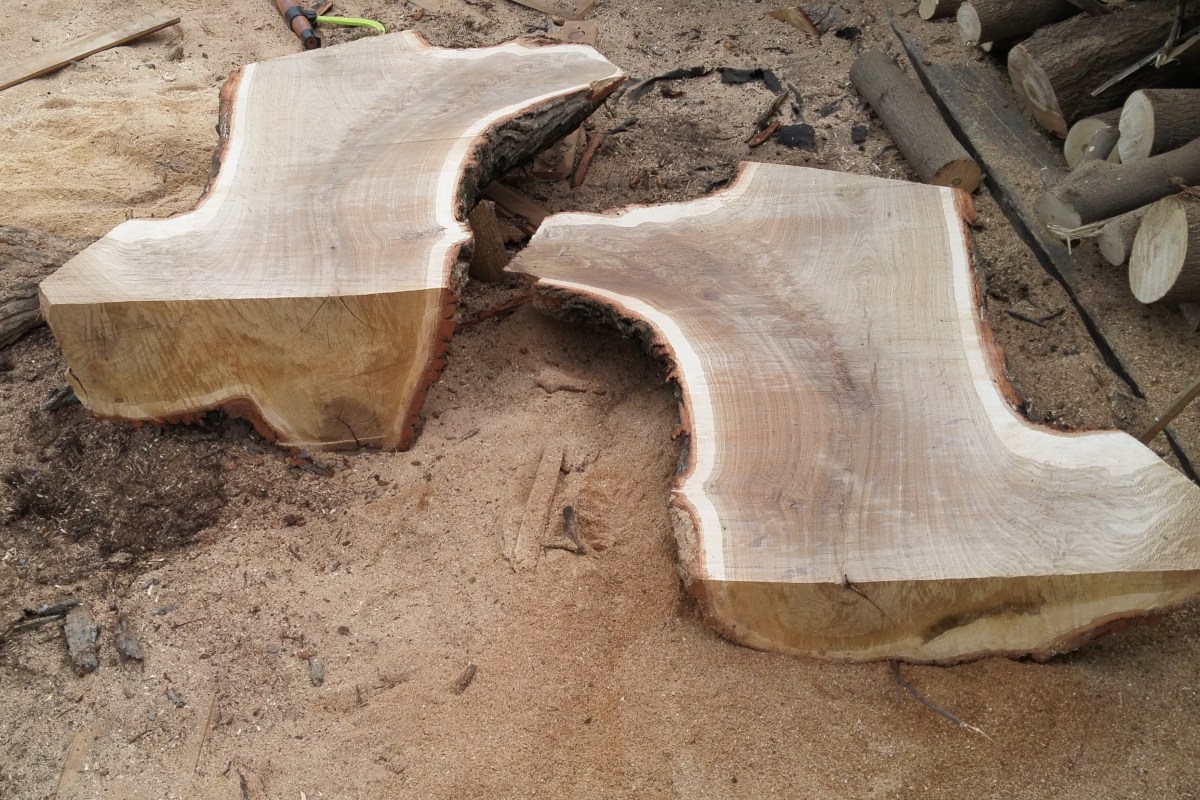Every homeowner with a yard has a tree removal story. It’s no wonder: The process is Herculean and expensive — not something one would soon forget.
Mine started last summer, when the 70-foot black walnut tree in my backyard had to come down. Our behemoth had been threatening the neighborhood long before I moved in two years earlier. I’d spend every storm holding my breath and eyeing the window as she creaked and moaned, a ghastly noise more akin to a wooden tall ship than a tree.
Sally (yes, we named her) had been identified as very old, and very sick. Impressively she was rotting from the bottom and the top; our trusted tree removal experts put her on hospice and advised that the best time to remove a tree of her size would be winter, because that’s when a tree is at its lightest (no leaves, less water). Unfortunately, after a late summer storm blew through, things got too dangerous, so our gal Sal had to come down immediately.
Slowly, we began to regard Sal not as a beloved living thing, but as a beloved dead thing — and one that could generate lumber. In a move that can only be described as COVID-era hobby mania, we began investigating options for re-using the wood. With the right support, backyard artisanship is deceptively achievable. First-timers can take aim at projects like raw-edge tables (take a board, stick some legs on it), cutting boards (cut one of your boards into a small rectangle), shelves (longer rectangle) or a bench (sturdier table). See? Simple.
I’m here to share what I’ve learned — and to evangelize, for you, too, can become a home-grown woodworker.
Identifying Potential Hobby Trees in Your Backyard
To be clear, I’m not advocating heading out into your yard and chopping down a tree to make a table. But when a neighborhood tree inevitably comes down, scavenge that timber!
Through our research, we met Adrian Plante, a wood artist based in Crystal Lake. The owner of Wood Urban Design, he’s been hewing commercial and residential projects and shipping them around the globe for over a decade. He regaled us with tales of one-of-a-kind pieces he’d created: headboards, countertops, even wooden sinks. A Chicagoan by way of a small mining town in Ontario, Canada, you’ll find this carpenter-meets-lumberjack character slicing up fallen trees all over Chicagoland, transforming them into heirloom pieces. He’s made all manner of tables, seating, and shelving — hell, he just shipped a 24-foot custom library shelf/window seat combo down to Florida last week.
Plante says the business of recycled tree goods is only picking up. Folks salvaging their own trees and turning them into sentimental pieces — a process Plante gleefully calls “tree to table” — made up almost all of his business last year. “[In 2021] it’s been a lot more heirloom, heritage-style projects,” Plante says. “Things like ‘I’ve been storing this wood from my grandmother’s tree for 30 years — can you turn it into two tables for her two grandkids?’”
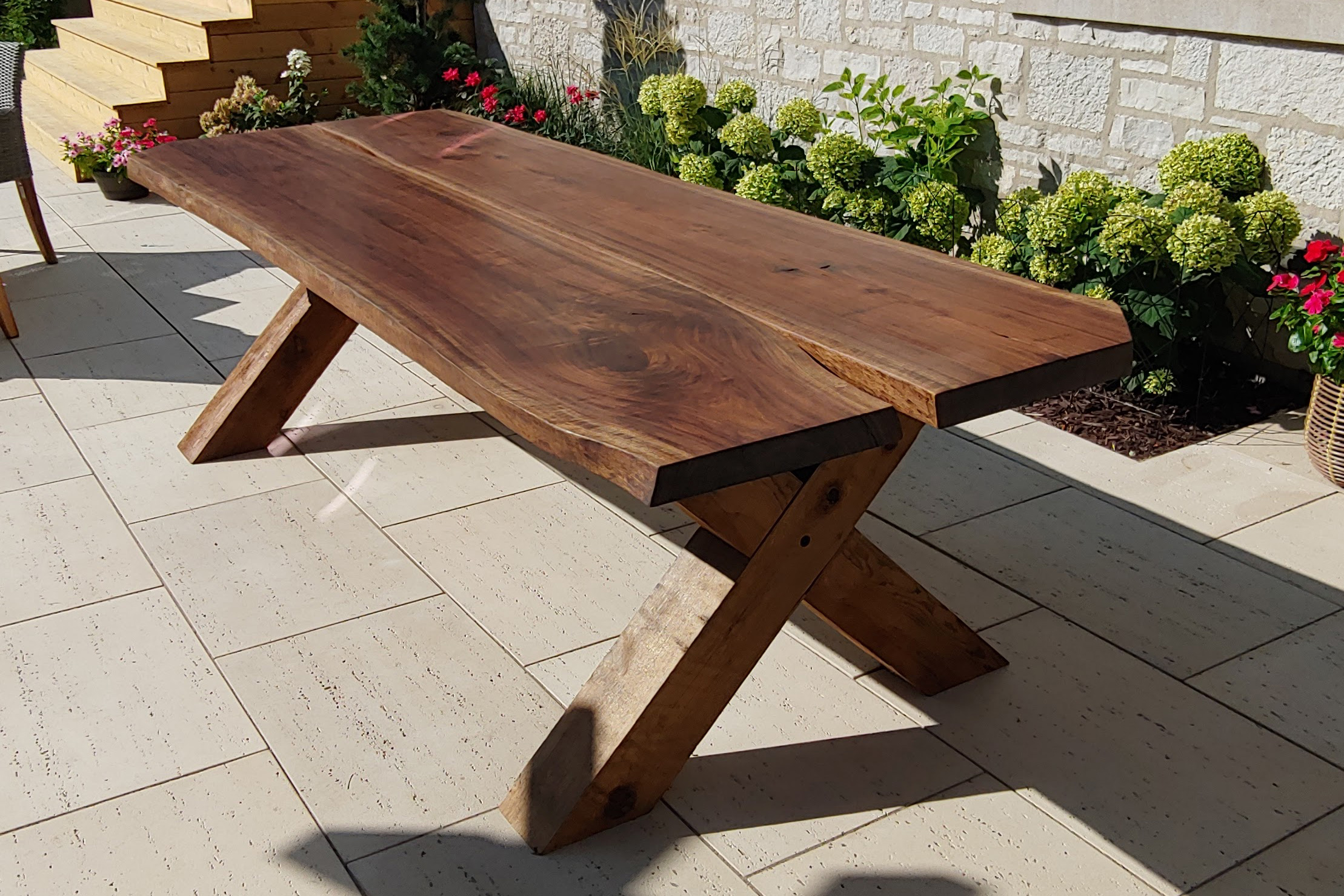
Carving pieces from your own trees is not just deeply personal, but also sustainable. “It’s a really good way of sequestering carbon,” Plante explains. “If you chip a tree or burn the wood, you are putting carbon back into the atmosphere. By building it into furniture, you’re trapping it.”
So are you a candidate for backyard woodworking?
Assess your trees, and keep your focus on hardwoods. (You can often identify these quickly by scoping broad — aka big — leaves.) In the Chicago area, we’re talking black walnut, silver maple, white oak and ash — but you have to get there before those infamous ash beetles mutilate them.
Black walnut is the big name in the group, known as a choice furniture wood due to its rich brown color and durability. It’s considered the most high-end, and even in its raw state, it can fetch a hefty price tag, though it’s less about quality and more about exclusivity – black walnut makes up a mere three percent of the United States tree canopy, Plante told me.
This created a fleeting moment of excitement on our journey with Sally the black walnut, but if you’ve got one of these in your backyard and are starting to see dollar signs, calm down. Like they told you, money doesn’t grow on trees. Let me be brief with the bad news:
- The cost to remove the tree (a necessary $9,000 expense in our case) will likely net out any potential revenue from selling raw wood boards.
- Lumber is no longer timbered gold. That’s right: “lumber prices are finally dropping after they soared during the pandemic.”
All that said, Plante encourages folks to use any wood they have an attachment to. “We just built a dining table out of a spruce that came down in a storm,” he says. “Any tree can be repurposed into furniture or some project as long as it’s healthy.” And he’s playing fast and loose with the term “healthy”: “If it’s alive and standing, it’s most likely good.”
Experts might make a quality call off reviewing a picture or coming on-site to do an in-person inspection, but it can be hard to judge a tree by its bark, so expect surprises. You might discover interior rotting, animal damage or even a live raccoon living in the trunk. (Completely bonkers story for another day, but let’s just say it didn’t end well for anyone.)
Once you’ve identified a tree, it’s time to decide how involved you want to be. There’s milling, drying and building, and that’s all after the tree is on the ground. A company like Wood Urban Design can complete every step for you, or hold your hand if you want to give certain aspects a shot. Plante routinely has customers call years later asking him to step in on a project. There’s no shame in the tree-to-table game.
Other option? Tap into your Midwestern sensibilities of straight-forward hard work and understated creativity and get saw dusty. Bob Villa. Ron Swanson. Tim “The Toolman” Taylor. If any of these names stir a slight thrill within, you might just be a woodworker. And the next time a storm blows through, you might just have sourced a family heirloom.
We went for the latter option.
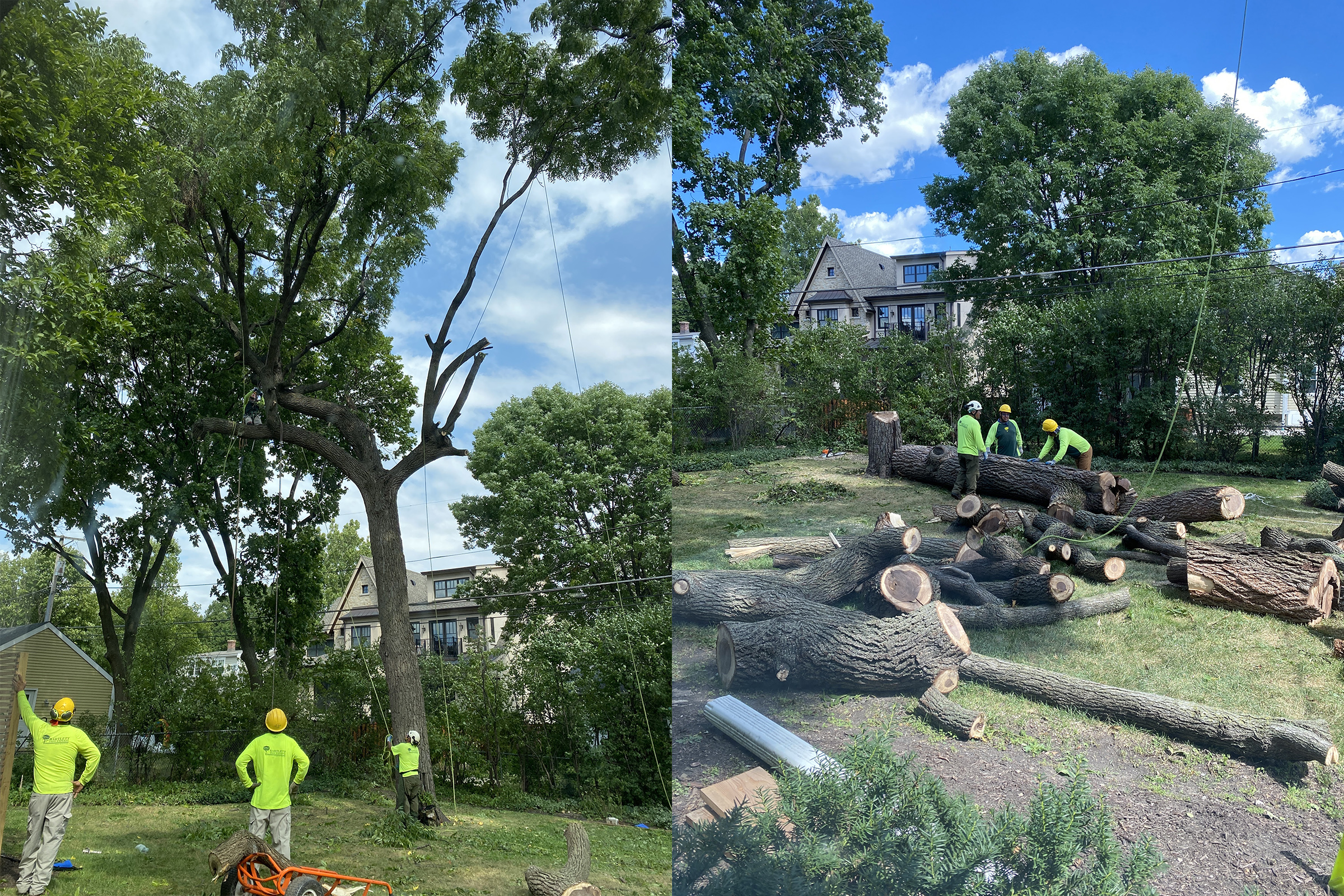
Generating Usable Hobby Wood From Standard Tree Removal, aka So Long, Sally
Our removal took two full days, with four workers working at least eight hours a day. Our tree extended probably 40 feet above the power line, so the removal had to be done in stages. Fun fact: Stage one requires the power to go out on the whole block, and an outage of that size has to be scheduled through the electric company.
Sections of the tree come down in chunks, and quite quickly, so if you’re hoping to salvage boards you need to be in constant communication with the tree removers. Quick shout out for the tree removers — these folks are part acrobat, part daredevil, part artist, and their level of expertise is mesmerizing. Scaling a dying tree with a literal chainsaw dangling from your belt? Grabbing onto said tree for dear life as a strong gust comes by? Getting struck by lightning!? The stories these people have…..
The end game here is to create your own lumber. As anyone who’s been to Home Depot knows, lumber comes in lots of sizes, so make sure you have a plan before the cutting starts. In general, max out the longest and widest you can go. Dimensions are referred to as board feet and include board thickness, which is measured in these odd, lopsided fractions. We grabbed a mix of 1” to 2” thick slabs — or “four quarter” and “eight quarter,” as the die-hards say.
The act of cutting boards out of a cylindrical tree arm is called milling, and there are three ways to do this:
- Chainsaw mill: Also referred to as an Alaskan Mill, this is the MacGyver option and includes attaching a chainsaw into some makeshift metal poles. Enter at your own risk.
- Portable bandsaw mill: The more professional version of the above. This was actually my introduction to Wood Urban Design. Adrian and his right-hand man Jakub came out with a portable saw mill. They moved and cut almost 100 boards in four hours for a mere $500, even carting them into the garages of our neighbors. Woodworking lust spreads, y’all.
- Commercial lumber processing: The true hurdle to this option is getting several thousand pounds of huge logs from your yard to their plant. Most tree removal companies will not do this. If you can find a way to transport the logs, you’ve got a shot. Any takers can check out this non-exhaustive directory of custom sawmills and woodworkers from the University of Illinois.
You’ll likely be riding high after all the boards come out. Finally, things are shaping up into something you can manage, something that looks like wood! But now comes the biggest stumbling block: The wood needs to dry. Family heirlooms aren’t built overnight.
Again, I’ll give you three options:
- At home: Create a DIY wood drying rack. It can live outside as long as it stays dry. Wood has to sit for a minimum of 12 months — likely more, depending on the board thickness.
- At a commercial oven: You’ll have to pay to play, but the upshot is fully dried wood in a quarter of the time. I used this option, opting for a kiln-drying company in the north burbs. They were a pain, so I’m not mentioning the name. It cost around $1,300 for around 300 board feet (which is only a fraction of the wood Sally gave us, R.I.P.).
- With Wood Urban Design: They dry wood for a minimum of two years, then pop it in the kiln two weeks before furniture production. Pricing is dependent on board feet, but generally runs $50-$250 per month.
Once your planks are dried, you’re ready to build.
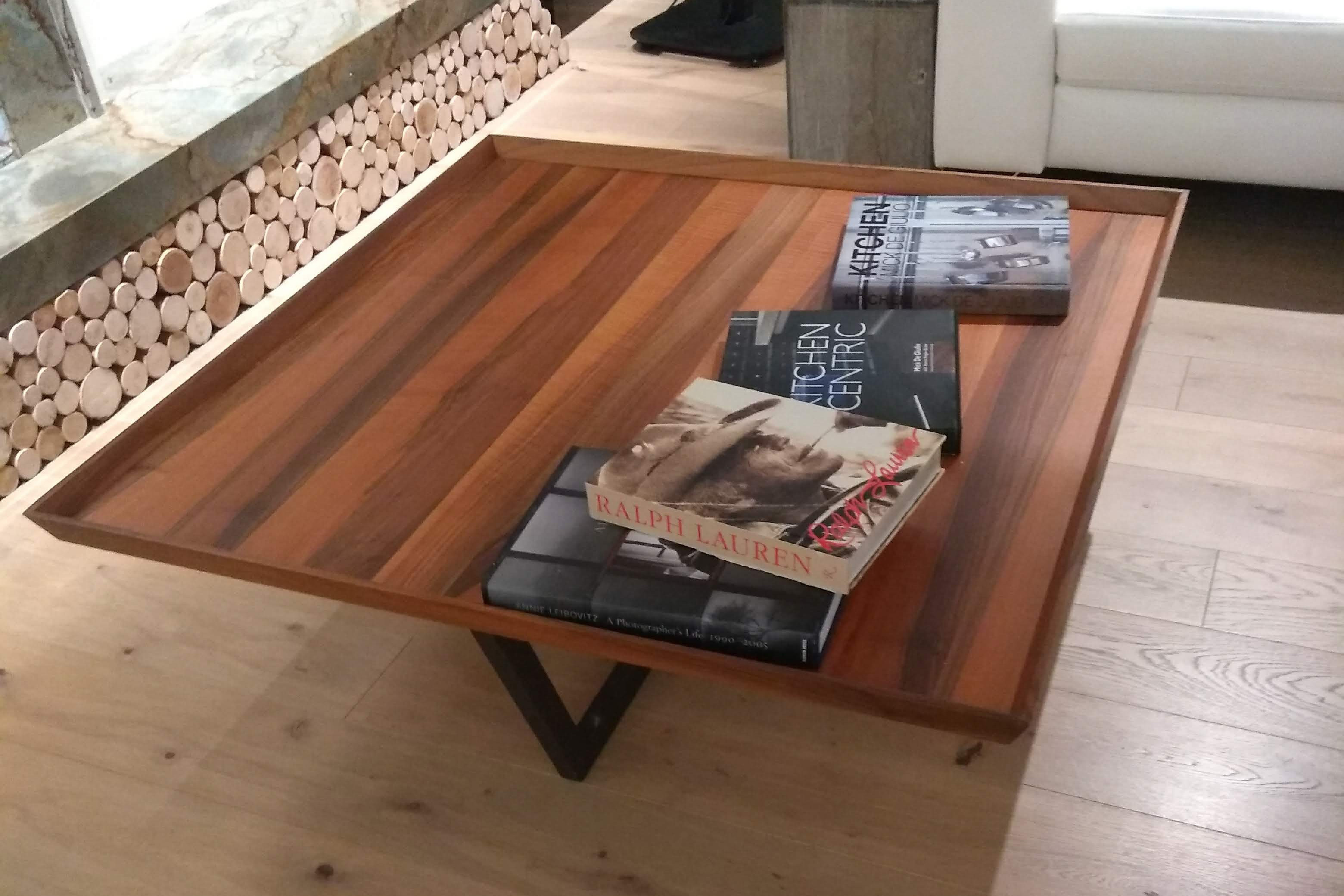
Creating an Heirloom Piece From Your Beloved Tree
Listen, woodworking is a big hobby. There are so many tools and so much jargon, but the dirty secret is you can try it out before committing in a huge way. Don’t be intimidated by board feet, jigs, counterbores, burl growths or parquetry. Whittle by whittle, you’ll get there.
While the wood dries, assemble your toolkit. Sure, any hobby requires a capital investment, but first decide what you want to build and assemble a toolkit for that specific project. Then add new tools as you begin new projects, that way you don’t get overwhelmed with all of the tools at once. For example, my husband set out to build an electric guitar. That requires lots of fine woodworking tools like a jointer/planer, bandsaw and palm router. I, on the other hand, aim to attach legs to a board and call it a table. I need glue, clamps, and a power drill.
Tool collection is a great way to get to know your neighbors. I found out one had a chainsaw, another had a scroll saw and another had a very big problem with me using these tools outdoors after 7 p.m. on Labor Day weekend.
Important note, while wood does lose a lot of weight when it dries, and therefore becomes marginally easier to move around, it doesn’t get smaller. Wood and the woodworking tools it requires take up a lot of space, so even a small project will require a small woodshop – could just be a dirty corner of the garage.
Here I am hand-planing a bit of Sally in the woodshop we carved out of our unfinished basement:
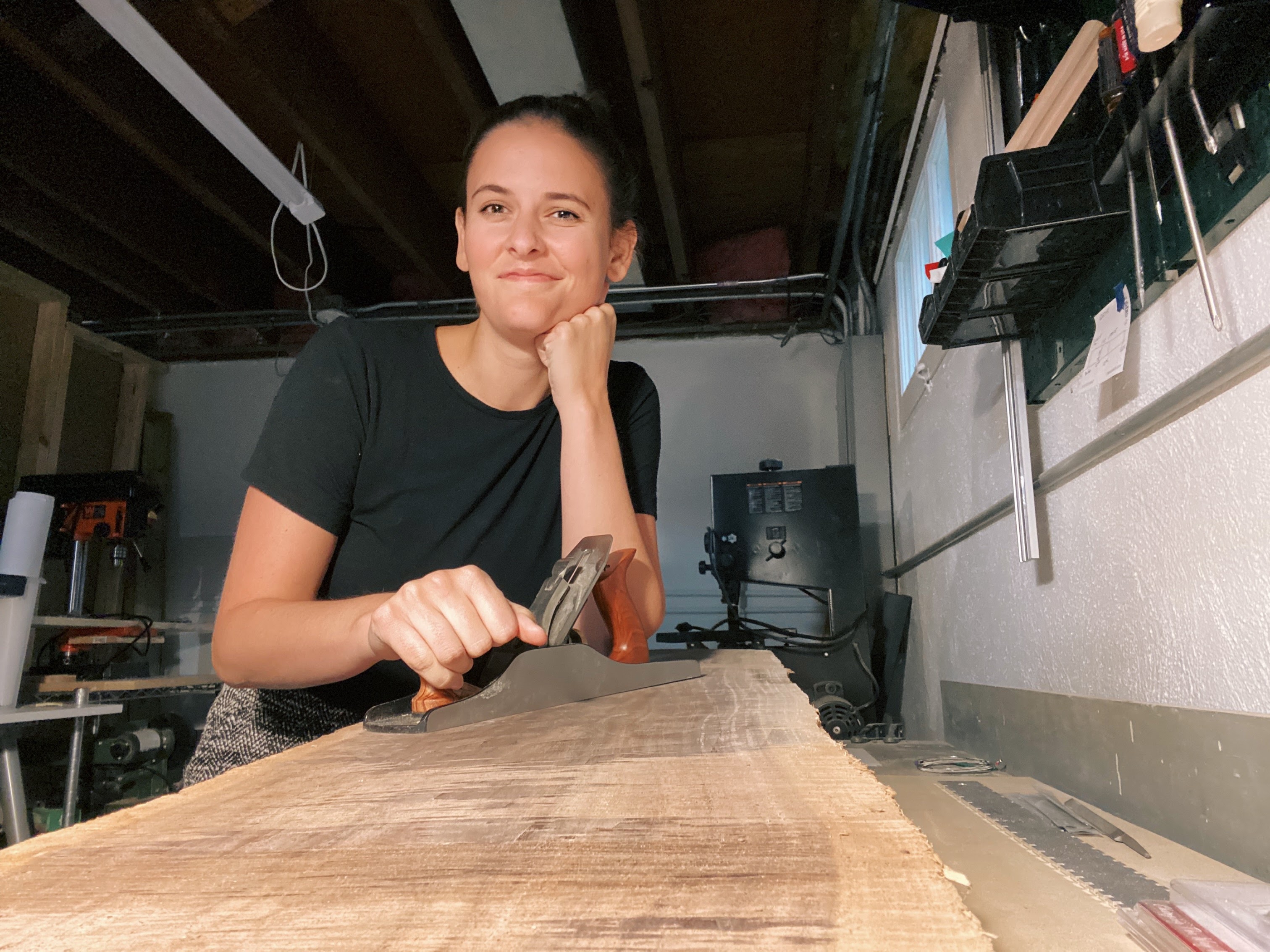
When the wood is dry, it’s time to tackle a small project. If you don’t have a project in mind, furniture and home decor are easy places to start, and raw wood is very en vogue. “Live-edge kitchen shelves are really hot right now,” Plante says. “We can’t keep them in stock, they’re literally flying off the shelf.” Peruse your favorite home furnishing catalogue for inspiration.
Here are a few things you could make on your own, while avoiding the four-figure price tags the big brands are hawking:
- Tree stump side table from West Elm: Super easy — you’ll just need to peel off the bark, let it dry (could take a year), then use a crosscut saw to even it out.
- Server plate from Crate & Barrel: Same as above, except in this case the tree removal team can probably give you the cuts you need; just sand it and let it dry.
- Reclaimed wood bench from Pottery Barn: Oh, you reclaimed that wood, alright. Benches are ubiquitous on woodworking sites. There’s plans for every taste, so find yours and get cracking.
- Live-edge tables from Room & Board: Not much to do here, resolve cracks of an original slab cut and add some legs.
In closing, yes, there’s plenty of warm weather left to be squeezed out of 2021, but let’s not kid ourselves, winter is coming. As the weather turns cold — and COVID-19 shows no signs of stopping — we need indoor hobbies. I’m not talking about early-phase pandemic hobbying like baking and puzzling. This is late-stage pandemic hobbying, the kind where you access deep cultural roots and are afforded a chance to live forever with your beloved tree/lumber/art.
Now you’ve got everything you need. Chop chop.
This article was featured in the InsideHook Chicago newsletter. Sign up now for more from the Windy City.
